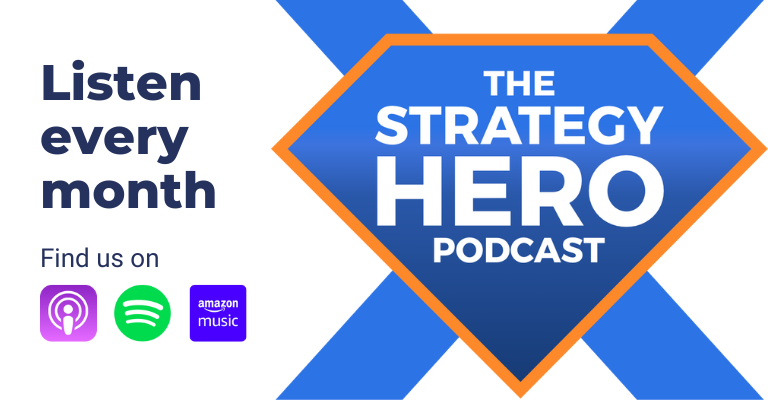As we kicked off season two of the Strategy Hero podcast, we wanted to start with a big idea, and we found that with Canalys analyst Jay McBain. Here's what I took from my time with him.
Heading into season two of the Strategy Hero podcast, we had a who's who of guests we wanted to speak to.
The name that bubbled to the top was someone who would bring something completely new to our audience and help us set sail for a season that followed that tone.
It was time to talk to Jay McBain about the decade of the ecosystems.
It’s important to note that my opinions do not reflect those of i-nexus or Jay McBain.
Enjoy!
Dramatic transformation is coming
When researching topics for Jay’s episode, including talking to the man himself, we came back to this idea of change. Not change in the sense we’ve discussed before – e.g., Rachel Neaman’s episode on change – but at a more seismic, tectonic plate level.
It’s fair to say that we, as leaders and those rising to the top of their fields, likely take for granted our worlds.
Sure, we see shifts in how we go to market (i.e. B2B, B2B, or C2C), or the way that we leverage our product to support how we win customers (Sales Led Growth v Product Led Growth), but these are not shifts in how we operate as businesses.
Industry 5.0 has been a term thrown around at increasing rates. AI has emerged with some tremendous growth in an astonishingly short period. But a sleeping giant has grown stronger in the shadows – the channel.
The smoke signals have been there arguably since 2019, with more businesses shifting towards a digital-first model friendly to the channel system:
"Digital product management is a core imperative…and accelerating adoption means that if you don’t start soon, you may never catch up."
Hung LeHong, VP Analyst at Gartner
And, with Google and Apple’s sweeping changes in the world of third-party cookies making it harder than ever for companies to reach their buyer, the ingredients for change, or what you may feel is an open-arm embrace towards the channel, is there.
We had just the person to set the stage and take the lead role.
Why Jay?
I touched on this at the top of this reflection, but Jay isn’t the sort of guest we typically have. You can hear me address it with my opening remarks, but don’t mistake this for anything other than a deliberate choice.
Many of our episodes focused on a world we knew, but we also know it pays to pick our heads up and look out toward the distance. In our episode about creating a winning strategy (available here), we explored that. To win is to prepare, to prepare is to see in to the future.
In season two, we wanted to equip you with more content that makes you stop and think about the future of your industry. We started the ball rolling with our first episode with Pascal Dennis, who proclaimed that you must protect your core business before innovating.
Jay fits the bill for addressing the innovation aspect.
Jay’s experience in a business such as Lenovo and looking from the outside as an analyst at Forrester meant he could offer a unique take on where markets were heading and build on Pascal’s talk track.
"We watch all 27 industries and the changes in the go-to-market and routes to market, but these changes are starting to creep up into the boardroom. CEOs are talking to us at a level they never have before…and what used to be a department over on the side [the channel]…is now crucial."
One of the advantages of speaking to people from the world of strategy, transformation, and operations is that it’s a known commodity. As a host, I got endless value from the concepts Jay spoke about – and has written about, too – and even the obvious things clicked.
For instance, Jay’s comment on how “everything runs through channels – your car is from a dealer, bread comes from a grocer” to an app from the app store is obvious, but it was the lens with which he presented the episode that took us out of the world of execution and into the strategic visionary.
That’s what’s changing – the shift from execution to strategy in the channel world.
Every company is quickly having to become a tech company
“Every company is quickly having to become a tech company, regardless of their industry.”
That’s a big claim, but the sort of claim you’d expect from someone who has their ear to the ground with CEOs, CIOs, and leaders for decades. That bold proclamation was backed up with plenty of convincing points.
For instance, Jay’s point on the 28 different touch points in the buying journey.
As a marketer, I spend countless time considering the 14 pieces of content I want a buyer to touch, but what about the conversations this person has with colleagues, visits to review sites, forum posts, events, and conversations at the watering hole (or cooler)?
The scale of interactions we go through is multiplying. It is too much for one business.
The shifting buyer compounds that – in one year, the predominant buyer across all industries will be a millennial. That means more information, more choice, and a buyer who wants things to be convenient, connected, and conducive to getting more done.
Sure, it means different things to manufacturers, automotive, banking, insurance, and pharma, but the agenda is clear – we must change or face extinction.
We’ve seen the shift here at i-nexus. What once was a buyer who would have several stages of demos and talks before seeing the product can now see it and try it themselves – we’re changing, but what we’re seeing now is only the beginning.
“Integration first” buyer
That’s the phrase that Jay frequently used.
Everything needs to either “integrate in my life (as a consumer), or needs to integrate into my business as a B2B buyer.”
A business’ ability to integrate with other businesses is more important than ever.
“If you’re an automotive leader of a $3tr industry that’s always done things a particular way and now you’re in front of this integration-first buyer, your technology alliances and your ability to be almost a technology company will decide whether you’re going to win or lose.”
If you follow Jay’s story, he explains that the CEO must consider radically changing the playing field.
Technology alliances mean that the traditional idea of buying/renting a car creeps into a concept of Transport as a Service – e.g., Hiyacar - where no one owns a car, but we get served the right kind of car at the right time.
That’s a subscription type of service.
“The move to becoming a tech company is perilous, and big tech is surrounding.”
3rd party cookieless world
Let's revisit the issue of the impending shift to a cookieless (well, third-party) world; this is one of the cases where buying habits are changing. The question is, how do you address this?
Well, that’s where the partner ecosystem comes in.
If you’re not working with the partner ecosystem, you’re missing out on most of the 28 touchpoints your buyers have.
As Jay puts it, one day, you wake up as a CEO and realize, “I’m missing deals in my sleep.”
The case is only strengthened when you consider how many partners Jay explains influence those 28 touch points. If you can find a way to align and “play nice” with them, you’ve got a better chance of winning.
Which makes sense. With fewer options to reach buyers you don’t know, it’s important to leverage those people who are inevitably influencing.
How?
Grab every watering hole
“As a leader, you need to grab as many of the water holes as possible” to be part of the conversations that drive purchases.
That means making changes now. And that doesn’t mean a change in your go-to-market.
Moving towards a partner-led model requires you to think deeply about your corporate strategy. That’s the sort of strategic issue you should be monitoring.
You need to change your corporate strategy to adapt to this shift. That means finding new ways to reach your buyers and the influencers on a deal.
That starts with leaders understanding their buyers inside out – asking the right questions from buyers and getting to know, inside out, what the 14 touchpoints are that you can’t get to. That comes from three simple questions, Jay states:
- What do you read
- Where do you go, and
- Who do you follow
With these answers, you’ll be able to map out your ecosystem.
And what does the leader of this new world look like?
“Every CEO on the planet must start sounding like a SaaS company now.
I need to know who I’m after TAM [total addressable market], I need to know the cash registers of how that all works (e.g. if I sell hamburgers I need to know how many restaurants I have on every corner), and get in front of my customer.
In the end, you want to know your buyer and understand where they are and how they’re moving through the 28 moments.
That means I’m building a company very friendly in an ecosystem around my customer.”
My takeaway
Getting our heads up out of the day and peer into the distance is important.
Perhaps, like all things analysts, you don't agree with the detail of the picture. But, the picture painted by Jay clearly shows that buying behaviors are shifting, and if you don't keep up, you're in trouble.
So, get closer to your market, understand what motivates buyers, learn how they consume information before buying, and be there with them - no matter how you get there (and it may just be through the channel ecosystem).
Thanks for being our first hero of the season, Jay!
Listen to the episode
Jay's episode was the first episode of season two of Strategy Hero.
You can click here to listen to Jay's episode or search "Strategy Hero" wherever you find your favorite podcasts.
About Strategy Hero
Published on the last Thursday of every month, the Strategy Hero podcast delves into the world of business strategy and transformation.
Each cast shines a spotlight on a Strategy Hero – inspirers, boundary pushers, and leaders of change from all walks of life – armed with practical advice on achieving your goals.
Episodes explore topics around operational excellence, Lean management, process improvement, change management, and much, much more. Available where all great podcasts live, listen on-demand today, and discover the Strategy Hero inside you.
About the host
James Milsom is Head of Marketing at i-nexus, but James is a storyteller. He’s the UK’s biggest Georgia Bulldogs fan (Go Dawgs!) and lives and breathes marketing.
The Strategy Hero podcast is his opportunity to bring some of his conversations with mentors, inspirers, and people anew to you every month.
He’s behind the content read and watched by people like you and lives to educate and help others.
If you’d like to learn more about him, connect with him on LinkedIn and subscribe to the Strategy Hero podcast today!



.jpg?width=352&name=KPIs%20(3).jpg)